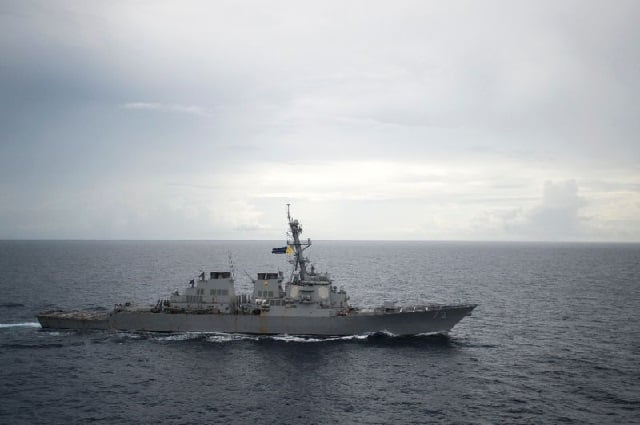
In what the US Navy has called an "unsafe and unprofessional" encounter, a Chinese warship sailed within just 45 yards (41 meters) of a US destroyer Sunday as it passed by Chinese-claimed features in the South China Sea, forcing the American vessel to take evasive action.
The close call capped days of tit-for-tat military moves that came as President Donald Trump ramped up his trade war with China.
"The close encounter between the Chinese destroyer and the USS Decatur was the closest one yet," Timothy Heath, senior international defense research analyst at the RAND Corporation, told AFP.
It "may reflect in part the growing US-China tensions. But it also appears to reflect a growing willingness by Beijing to test the Americans in the South China Sea," he added.
Beijing reacted furiously after the incident, saying America's "freedom of navigation" operation threatened China's sovereignty and security, and damaged military relations between the two powers.
Even in new trade deal, US plays hardball with China
The encounter followed a string of other military incidents.
Last week, plans for a Beijing meeting between US Defense Secretary Jim Mattis and his Chinese counterpart General Wei Fenghe fell through after China declined to make Wei available.
Days earlier, China nixed a planned port visit of a US warship to Hong Kong, and cancelled a meeting between the head of the Chinese navy and his American counterpart.
That all came around the time US B-52 bombers took part in a combined operation with Japan over the East China Sea, and flew through international airspace over the South China Sea.
The Chinese defence ministry denounced the flyovers as "provocative" actions.
Mattis this week acknowledged "tension points" between the US and China, but told reporters he did not "see it getting worse."
The US and Chinese militaries in 2014 agreed on a code of conduct for unplanned encounters at sea, aimed at helping the two navies avoid mishaps.
It was unclear whether Sunday's manoeuver came at Beijing's request — or was initiated by the Chinese ship's captain — but political motivations were likely a factor in forcing a close call.
"With tensions elevated, China seems motivated to risk a possible collision as a means of intimidation. There is a real risk of miscalculation," Heath said.
Trump signs defense policy bill with watered-down China measures
Trump's trade war has infuriated Beijing, as did his authorization of a $1.3 billion arms sale to Taiwan, which China considers a rebel province.
Washington last week enacted new tariffs against China covering another $200 billion of its imports.
And Washington has placed financial sanctions on China for its recent purchase of Russian Sukhoi Su-35 fighter jets and S-400 surface-to-air missile systems.
US-China military relations have been strained before.
Military exchanges between the countries, including port calls, were temporarily suspended following a mid-air collision between a US EP-3 spy plane and Chinese fighter in 2001 off the south China coast that sparked a major diplomatic row.
The Chinese fighter pilot was killed in the collision and the EP-3 was forced to make an emergency landing in China's Hainan Island, with the crew detained for 11 days before being released.
Current military tensions are likely to persist, said Bonnie Glaser, a senior adviser at the Center for Strategic and International Studies, as they suit Trump's political objectives.
The president last week slapped $200 billion in tariffs on Chinese goods and has accused Beijing of interfering in the upcoming US election.
"This looks like a strategy from the president," Glaser told AFP.
"He just wants to double down on putting as much pressure on China as possible."
Noting that such actions violated established rules, Glaser added the encounter in the South China Sea represented a "different level of interfering" in a US freedom of navigation operation.






1736409688-0/sidra--(51)1736409688-0-270x192.webp)
1736410785-0/Express-Tribune-(5)1736410785-0-270x192.webp)
1736419163-0/sidra--(55)1736419163-0-270x192.webp)

1736421877-0/sidra--(56)1736421877-0-270x192.webp)




1736332856-0/Untitled-design-(20)1736332856-0-270x192.webp)







COMMENTS
Comments are moderated and generally will be posted if they are on-topic and not abusive.
For more information, please see our Comments FAQ